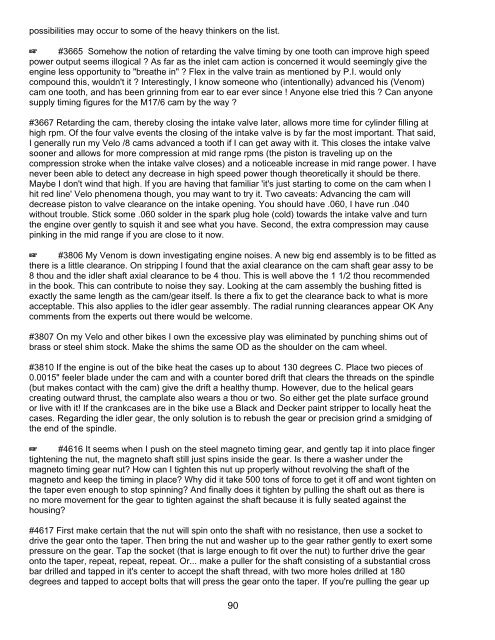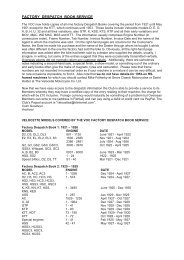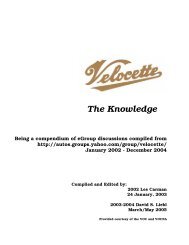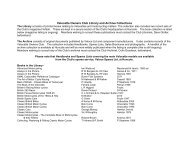The Knowledge - Velocette Owners Club
The Knowledge - Velocette Owners Club
The Knowledge - Velocette Owners Club
Create successful ePaper yourself
Turn your PDF publications into a flip-book with our unique Google optimized e-Paper software.
possibilities may occur to some of the heavy thinkers on the list.<br />
L #3665 Somehow the notion of retarding the valve timing by one tooth can improve high speed<br />
power output seems illogical ? As far as the inlet cam action is concerned it would seemingly give the<br />
engine less opportunity to "breathe in" ? Flex in the valve train as mentioned by P.I. would only<br />
compound this, wouldn't it ? Interestingly, I know someone who (intentionally) advanced his (Venom)<br />
cam one tooth, and has been grinning from ear to ear ever since ! Anyone else tried this ? Can anyone<br />
supply timing figures for the M17/6 cam by the way ?<br />
#3667 Retarding the cam, thereby closing the intake valve later, allows more time for cylinder filling at<br />
high rpm. Of the four valve events the closing of the intake valve is by far the most important. That said,<br />
I generally run my Velo /8 cams advanced a tooth if I can get away with it. This closes the intake valve<br />
sooner and allows for more compression at mid range rpms (the piston is traveling up on the<br />
compression stroke when the intake valve closes) and a noticeable increase in mid range power. I have<br />
never been able to detect any decrease in high speed power though theoretically it should be there.<br />
Maybe I don't wind that high. If you are having that familiar 'it's just starting to come on the cam when I<br />
hit red line' Velo phenomena though, you may want to try it. Two caveats: Advancing the cam will<br />
decrease piston to valve clearance on the intake opening. You should have .060, I have run .040<br />
without trouble. Stick some .060 solder in the spark plug hole (cold) towards the intake valve and turn<br />
the engine over gently to squish it and see what you have. Second, the extra compression may cause<br />
pinking in the mid range if you are close to it now.<br />
L #3806 My Venom is down investigating engine noises. A new big end assembly is to be fitted as<br />
there is a little clearance. On stripping I found that the axial clearance on the cam shaft gear assy to be<br />
8 thou and the idler shaft axial clearance to be 4 thou. This is well above the 1 1/2 thou recommended<br />
in the book. This can contribute to noise they say. Looking at the cam assembly the bushing fitted is<br />
exactly the same length as the cam/gear itself. Is there a fix to get the clearance back to what is more<br />
acceptable. This also applies to the idler gear assembly. <strong>The</strong> radial running clearances appear OK Any<br />
comments from the experts out there would be welcome.<br />
#3807 On my Velo and other bikes I own the excessive play was eliminated by punching shims out of<br />
brass or steel shim stock. Make the shims the same OD as the shoulder on the cam wheel.<br />
#3810 If the engine is out of the bike heat the cases up to about 130 degrees C. Place two pieces of<br />
0.0015" feeler blade under the cam and with a counter bored drift that clears the threads on the spindle<br />
(but makes contact with the cam) give the drift a healthy thump. However, due to the helical gears<br />
creating outward thrust, the camplate also wears a thou or two. So either get the plate surface ground<br />
or live with it! If the crankcases are in the bike use a Black and Decker paint stripper to locally heat the<br />
cases. Regarding the idler gear, the only solution is to rebush the gear or precision grind a smidging of<br />
the end of the spindle.<br />
L #4616 It seems when I push on the steel magneto timing gear, and gently tap it into place finger<br />
tightening the nut, the magneto shaft still just spins inside the gear. Is there a washer under the<br />
magneto timing gear nut? How can I tighten this nut up properly without revolving the shaft of the<br />
magneto and keep the timing in place? Why did it take 500 tons of force to get it off and wont tighten on<br />
the taper even enough to stop spinning? And finally does it tighten by pulling the shaft out as there is<br />
no more movement for the gear to tighten against the shaft because it is fully seated against the<br />
housing?<br />
#4617 First make certain that the nut will spin onto the shaft with no resistance, then use a socket to<br />
drive the gear onto the taper. <strong>The</strong>n bring the nut and washer up to the gear rather gently to exert some<br />
pressure on the gear. Tap the socket (that is large enough to fit over the nut) to further drive the gear<br />
onto the taper, repeat, repeat, repeat. Or... make a puller for the shaft consisting of a substantial cross<br />
bar drilled and tapped in it's center to accept the shaft thread, with two more holes drilled at 180<br />
degrees and tapped to accept bolts that will press the gear onto the taper. If you're pulling the gear up<br />
90





